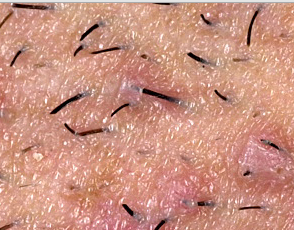
You might get ingrown hair because of how you remove hair, the clothes you wear, or even the type of hair you have. Ingrown hair is a common problem and there are several causes.
#Ingrown hair scars on vag skin#
However, some hairs may grow under the skin and cause a negative reaction, because it senses the hair shaft is a foreign object. When hair is removed, it usually grows back up through the skin without any problems. Moisturize well after applying retinoids because these substances can cause dryness.īe sure to consult with your doctor before using retinoids, since this medication is dangerous for pregnant women and may cause birth defects in unborn children. If you’re concerned about the dark patches that formed because of the ingrown hair, you can use retinoids like tretinoin (Retin-A or Renova) to clear up the dead skin cells. Other creams your doctor may prescribe are:


A topical steroid cream can help you soothe the itchiness and lower the risk of infection. Inflammation, redness, and discomfort may be caused by ingrown pubic hair, so you can call your doctor to prescribe an ointment or cream that can reduce the swelling and irritation. Let it sit for 10 minutes then wash with warm water.ĥ) Use ointments or creams to reduce inflammation Make a paste with half a cup of brown or white sugar and olive oil, then apply on the area in a circular motion. Sugar: Sugar is a natural exfoliator that can kill bacteria.Apply this with a cotton ball then rinse with cold water. In one cup of water, mix a tablespoon of baking soda. Baking soda: Baking soda can reduce inflammation in the skin.Dilute the oil with water and apply to the affected area with a cotton ball. Tea tree oil: Another acne medicine, tea tree oil can kill bacteria and bring down swelling.Benzoyl peroxide cream: This acne medicine can reduce the redness and inflammation in the affected area.It’s best to avoid them if you currently have ingrown hair, since these substances may cause irritation. Salicylic or glycolic acid: These products can keep your hair follicles open to prevent hair from getting trapped.Over-the-counter (OTC) products and home remedies are also a great way to relieve bumps and prevent ingrown hairs. This can also dislodge any dirt, oils, or dead skin cells that trap the ingrown hair. With a wet washcloth, rub around the bump in a circular motion. Gently washing, exfoliating, and rubbing around the bumps everyday can guide the hair to return to the skin’s surface. Avoid digging or breaking into the area because this may cause an infection. The area needs to heal first, or else the skin will heal over the hair follicle underneath. Make sure that the tip is out of the skin before waiting to pluck it out completely. You can draw out the top of the hair with a needle. With a pair of sterile tweezers, gently pull the hair that emerges. 3) Gently tweeze out the hair when it appears

This will open up the follicles so you can pluck out the ingrown hairs. Once the washcloth cools, run it under hot water and repeat the process. Run a clean washcloth under hot water, then press it against the bump in a circular motion for 3-4 minutes. Pulling or picking at the ingrown hair.Ī warm compress will also help bring out the ingrown hair so you can remove it easily.You should also avoid doing the following: Continuing to remove hair will aggravate the sensitive area, and may cause an infection or a scar. If you feel an ingrown hair bump causing you irritation and pain in the vaginal area, it’s important to stop shaving, plucking, or waxing until the bump goes away. 9 When to Consult With Your Doctor 1) Stop shaving, waxing, and plucking


 0 kommentar(er)
0 kommentar(er)
